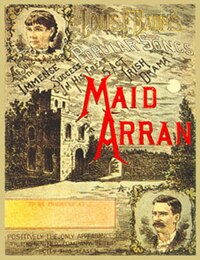The Maid of Arran
| The Maid of Arran | |
|---|---|
| An Irish Idyl in 5 Acts | |

Cover of the songbook
|
|
| Music | L. Frank Baum |
| Lyrics | L. Frank Baum |
| Book | L. Frank Baum |
| Basis |
A Princess of Thule by William Black |
| Productions | Touring: 1882-1883 Syracuse 1885 |
The Maid of Arran, An Idyllic Irish Drama Written for the People, Irrespective of Caste or Nationality is an 1882 musical play by L. Frank Baum, writing and performing under the pseudonym, "Louis F. Baum", based on the novel A Princess of Thule by William Black. It was described as "A Play to Ensnare All Hearts and Leave an Impress of Beauty and Nobility Within the Sordid Mind of Man." The play resets the novel from Scotland's Outer Hebrides to Ireland (although Arran is actually in Scotland—Baum probably meant Aran, but never changed it). This was a well-received melodrama with elaborate stage effects, including a storm upon a ship, and an original score by Baum himself. Unfortunately, only the songbook for the windows use survives, which omits two of the songs referenced in the script (the manuscript did not include the lyrics). Baum played the main character, Hugh Holcomb, originally called Frank Lavender in the novel, in its initial tour (including two stints on Broadway), and later played Con. O'Mara, the heroine's father, in a community theatre revival.
The play heavily alters Black's original to fit with the conventions of popular melodrama. The novel's sympathetic older male takes a Gregory Maguire-like turn that exists only in the mind of the novel's Frank Lavender. While Baum does not omit all of Lavender's unsympathetic qualities from Hugh, it is still quite obvious who we are to read as the hero, something Black leaves more to the reader to decide.
The play opened on Baum's 26th birthday, May 15, 1882, and headlined Agnes Hallock as Shiela O'Mara (Black's Sheila Mackenzie—note spelling difference), the daughter of the King of Arran, Con. O'Mara (John F. Ryan). She sang the songs "The Legend of Castle Arran" and "Ship Ahoy!", the latter being lost. Oona Kearney, the female character lead and equivalent of Black's Mairi, was played by Genevieve Rogers. Her songs included "Oona's Gift: A Tuft of the Old Irish Bog" and "A Pair o' Blue Eyes". Baum's aunt, Katharine Gray, who ran the Syracuse Oratory School, played Harriet Holcomb (Black's Caroline Lavender), and played a smaller role created by Baum, The Prophetess, under the name "Kate Roberts". Her maid, Gray (Black's Mrs. Paterson) was played by Cordie Aiken. John L. Morgan played Captain John Ingram, a moustache-twirling villain inspired by Black's Edward Ingram, who wants Shiela for himself. Edward Ingram merely offers her friendship that arouses Lavender's ire, partly because he's known Lavender long enough to understand how he can hurt people. Not remarked on much at the time were John H. Nicholson as Phadrig o' the Pipes, a very large but non-singing supporting role, based on Black's John the Piper. He is a friend to all the good guys and helps them out of jams, despite being a wiry old man. Mike J. Gallagher played the juvenile lead, Dennie, performing "A Rollicking Irish Boy". His character has no real equivalent in the novel, but has elements of Johnny Eyre and the much older character Duncan Macdonald. Mrs. Cecelia Lorraine comes over wholesale from the novel, but is only talked about, never shown (in the novel, she ultimately married Edward Ingram). Rounding out the original cast were C.F. Edwards as the Boatswain of the Malabar and C.H. Dennison as Fetchum, a valet not mentioned in the script. The other songs were "When O'Mara Is King Once Again", performed by Con. O'Mara, and "Sailing" performed by a chorus of sailors. Although the songs often interrupted the flow of the melodrama, they all grow out of the story and develop its characters, making it a primitive example of organic musical. "Oona's Gift" does the most to advance the story, and is indeed inspired by a scene in Black's novel. The play was very successful, especially with Irish audiences, in spite of its stereotyping, as it was much more sympathetic and, despite all its corny melodrama, did not reduce them to caricatures. The play, however, was panned in Richmond, Indiana, where it ultimately closed on June 7, 1883.
...
Wikipedia
